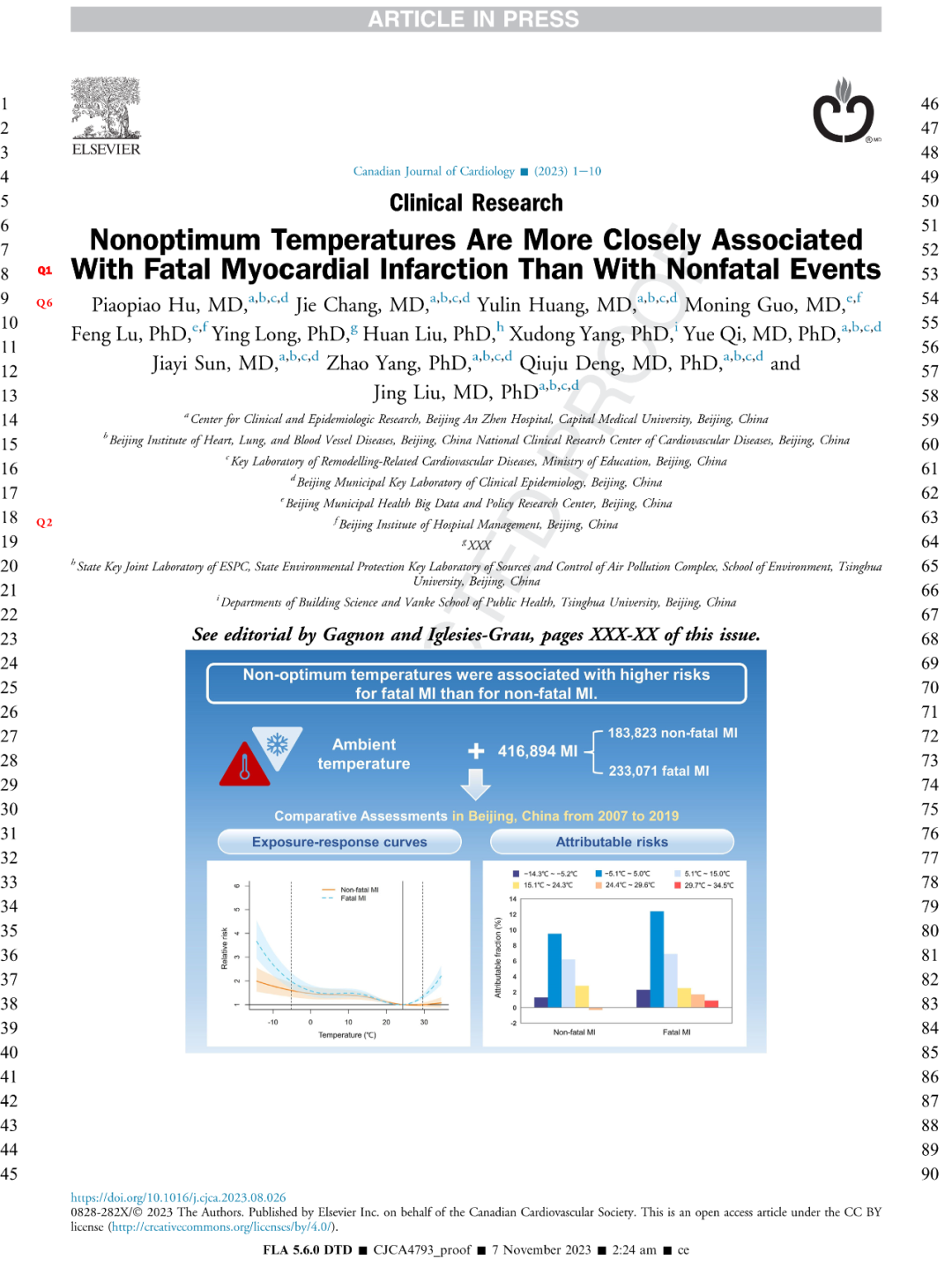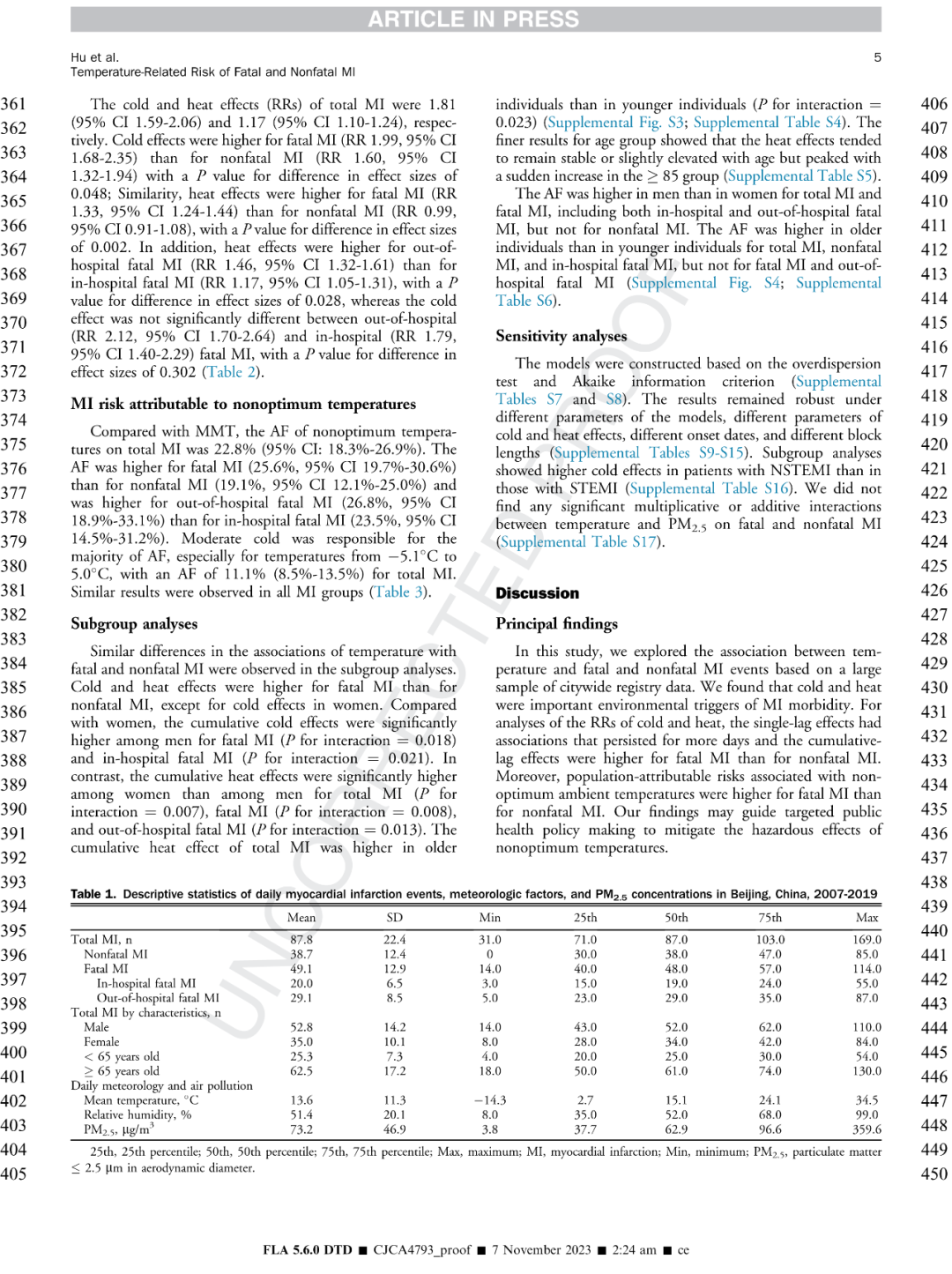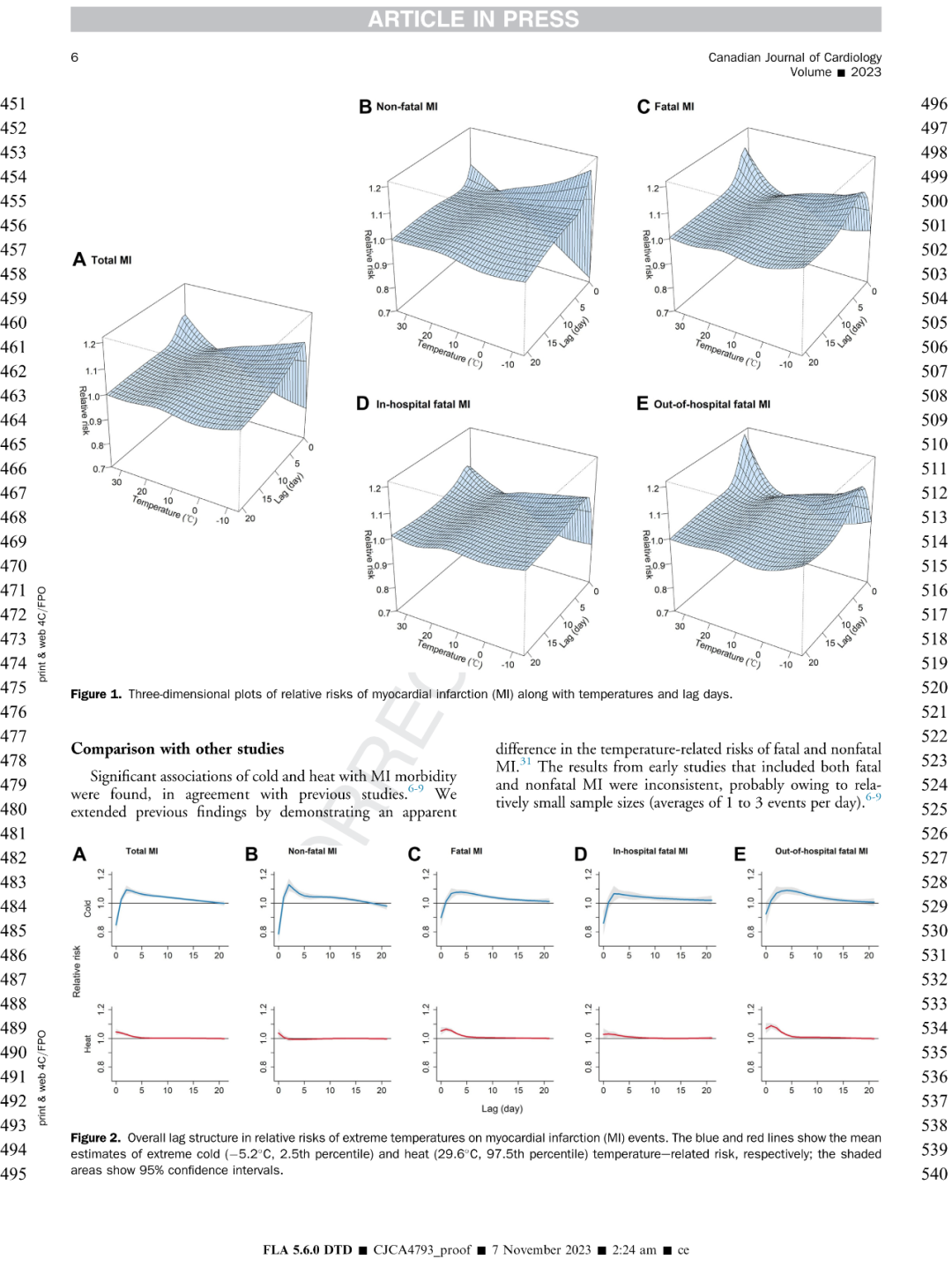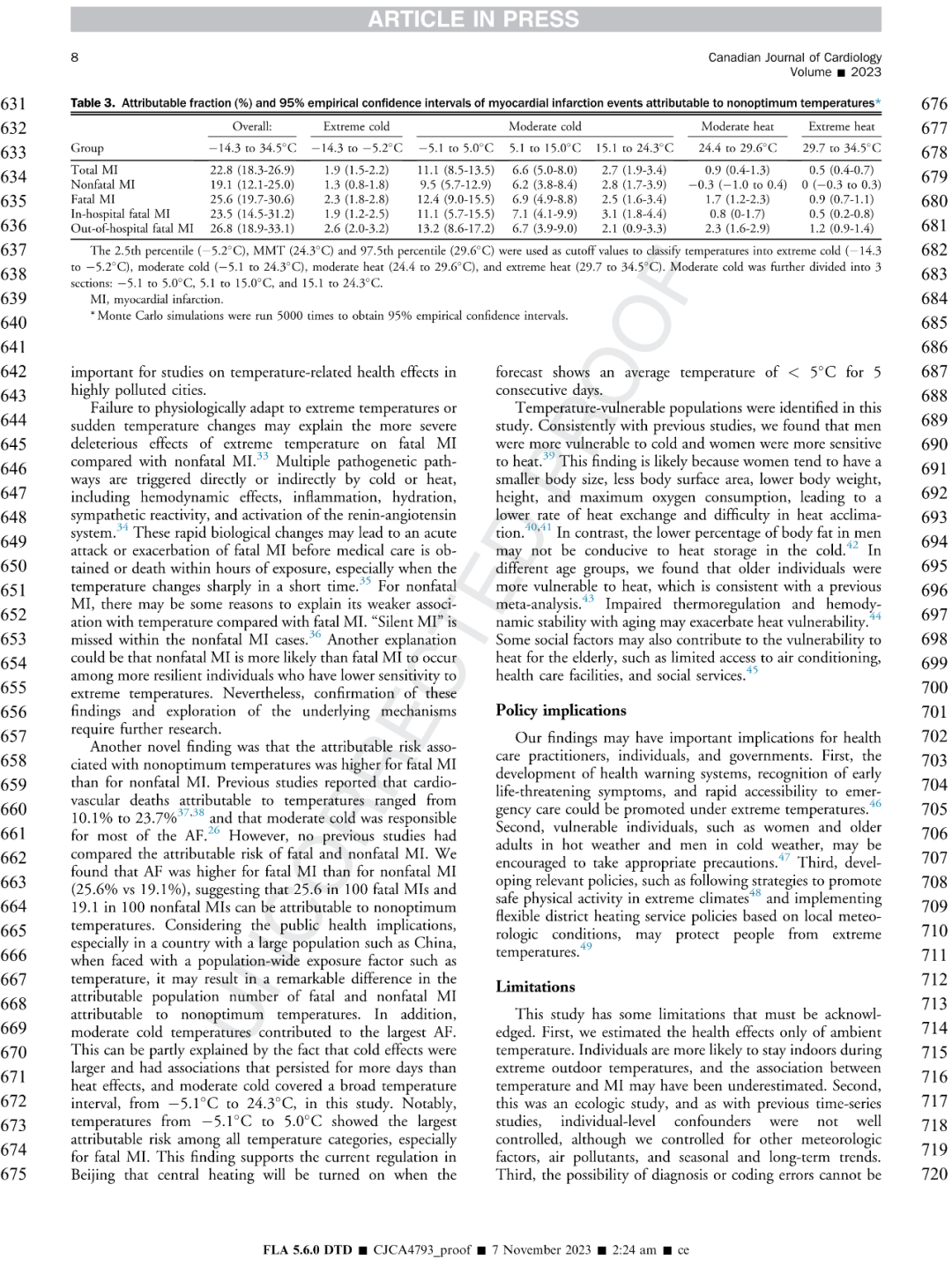本期为大家推荐的内容为论文《Nonoptimum Temperatures Are More Closely Associated With Fatal Myocardial Infarction Than With Nonfatal Events》(非理想温度与致死性心肌梗塞的关系比与非致死性事件的关系更密切),发表 Canadian Journal of Cardiology 期刊上,欢迎大家学习与交流。
背景
环境温度的变化会导致心肌梗塞(MI)患者的住院、死亡和急诊科就诊。然而,致命和非致命心肌梗塞与非理想温度相关的风险尚未进行比较。
方法
从2007年至2019年,在中国北京,共识别出416,894例心肌梗塞事件(其中233,071例致命,183,823例非致命)。使用分布滞后非线性模型的时间序列分析,比较了与非理想温度相关的致命和非致命心肌梗塞的相对风险和人群归因风险。
结果
参考的最适温度为24.3°C。对于单滞后效应,寒冷(-5.2°C)和热量(29.6°C)的影响对致命心肌梗塞的持续时间比非致命心肌梗塞更长。在0至21天的累积滞后效应中,寒冷对致命心肌梗塞的影响更大(相对风险[RR] 1.99,95%置信区间[CI] 1.68-2.35),而非致命心肌梗塞的相对风险为1.60(95% CI 1.32-1.94),两者效应大小差异的P值为0.048。此外,热量对致命心肌梗塞的影响也更大(RR 1.33,95% CI 1.24-1.44),相较于非致命心肌梗塞(RR 0.99,95% CI 0.91-1.08),两者效应大小差异的P值为0.002。非理想温度的归因分数对致命心肌梗塞更高(25.6%,95% CI 19.7%-30.6),而对非致命心肌梗塞为19.1%(95% CI 12.1%-25.0%)。
结论
与非致命心肌梗塞相比,致命心肌梗塞与非理想温度的关联更为密切。这一点体现在单滞后效应的持续时间更长、累积滞后效应更高以及对致命心肌梗塞的归因风险更高。需要采取策略以减轻非理想温度的不良影响。


题目:Nonoptimum Temperatures Are More Closely Associated With Fatal Myocardial Infarction Than With Nonfatal Events
(非理想温度与致死性心肌梗死的关系比与非致死性事件的关系更密切)
作者:
Piaopiao Hu, Jie Chang, Yulin Huang, Moning Guo, Feng Lu, Ying Long, Huan Liu, Xudong Yang, Yue Qi, Jiayi Sun, Zhao Yang, Qiuju Deng* and Jing Liu*
发表刊物:
Canadian Journal of Cardiology
DOI:
https://doi.org/10.1016/j.cjca.2023.08.026
URL:
https://www.sciencedirect.com/science/article/pii/S0828282X23016458
摘要ABSTRACT
Ambient temperatures trigger hospitalisation, mortality, and emergency department visits for myocardial infarction (MI). However, nonoptimum temperature–related risks of fatal and nonfatal MI have not yet been compared.
Methods
From 2007 to 2019, 416,894 MI events (233,071 fatal and 183,823 nonfatal) were identified in Beijing, China. A time-series analysis with a distributed-lag nonlinear model was used to compare the relative and population-attributable risks of fatal and nonfatal MI associated with nonoptimum temperatures.
Results
The reference was the optimum temperature of 24.3°C. For single-lag effects, cold (−5.2°C) and heat (29.6°C) effects had associations that persisted for more days for fatal MI than for nonfatal MI. For cumulative-lag effects over 0 to 21 days, cold effects were higher for fatal MI (relative risk [RR] 1.99, 95% confidence interval [CI] 1.68-2.35) than for nonfatal MI (RR 1.60, 95% CI 1.32-1.94) with a P value for difference in effect sizes of 0.048. In addition, heat effects were higher for fatal MI (RR 1.33, 95% CI 1.24-1.44) than for nonfatal MI (RR 0.99, 95% CI 0.91-1.08) with a P value for difference in effect sizes of 0.002. The attributable fraction of nonoptimum temperatures was higher for fatal MI (25.6%, 95% CI 19.7%-30.6) than for nonfatal MI (19.1%, 95% CI 12.1%-25.0%).
Conclusions
Fatal MI was more closely associated with nonoptimum temperatures than nonfatal MI, as evidenced by single-lag effects that have associations which persisted for more days, higher cumulative-lag effects, and higher attributable risks for fatal MI. Strategies are needed to mitigate the adverse effects of nonoptimum temperatures.








更多相关的研究工作详见BCL的【Healthy Cities】单元链接:
https://www.beijingcitylab.com/projects-1/34-healthy-cities/
(复制至浏览器搜索或点击文末“阅读原文”查看)
BCL北京城市实验室“健康城市” (Healthy Cities)项目还包括《中国北京急性心肌梗死患者的建成环境暴露与预后复发风险的关系》《北京地区急性心肌梗死患者到最近可行经皮冠状动脉介入术医院的驾驶时间与病死风险的关联研究》《社区基础设施相关的风险因素对慢性非传染性疾病的影响:系统性元综述》《百度大数据携手清华大学助力世界卫生组织,关注“城市吸烟问题”,推进“健康城市”发展》等研究内容,欢迎探索。
更多内容,请点击微信下方菜单即可查询。
请搜索微信号“Beijingcitylab”关注。

Email:BeijingCityLab@gmail.com
Emaillist: BCL@freelist.org
新浪微博:北京城市实验室BCL
微信号:beijingcitylab
网址: http://www.beijingcitylab.com
责任编辑:马悦、张业成
原文始发于微信公众号(北京城市实验室BCL):论文推荐 | 非理想温度与致死性心肌梗塞的关系比与非致死性事件的关系更密切
 规划问道
规划问道









